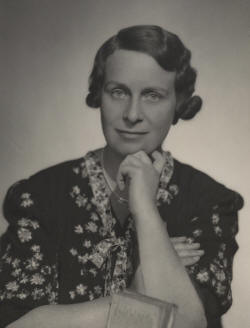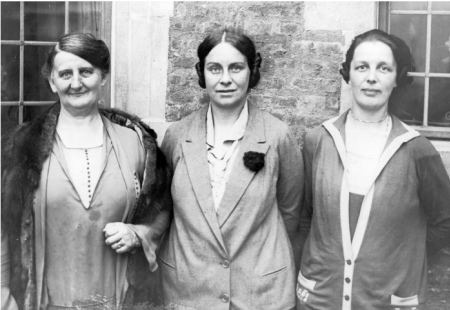

Queer Places:
Haslett Avenue East, Three Bridges, Crawley, West Sussex
Bungay NR35 1EH,
Suffolk
City of London Cemetery and Crematorium
Newham, London Borough of Newham, Greater London, England
 Dame Caroline Harriet Haslett, DBE, JP (August 17, 1895 – January 4, 1957) was a single woman
who trained as an engineer and was to become the founder of the
Electrical Association for Women. She poured her energies into
championing the cause of women in the electrical industry. Life could be
wonderful for singles, she maintained. ‘The world is hers for the
winning… What can the time of our aunts offer in comparison?’ At the age
of forty-three, her own appetite for life was intense: "Gardening gives
me great pleasure and the delights of driving are such that I have used
a car for many years in London… I find myself heartened and invigorated
by visits to the theatre… I play golf, and swim, and row with great zest
and some competence, and I even play tennis at times. Though I
thoroughly enjoy skating, I am far from the competition stage! I revel
in the public forum… Books still have an irresistible appeal for me."
Dame Caroline Harriet Haslett, DBE, JP (August 17, 1895 – January 4, 1957) was a single woman
who trained as an engineer and was to become the founder of the
Electrical Association for Women. She poured her energies into
championing the cause of women in the electrical industry. Life could be
wonderful for singles, she maintained. ‘The world is hers for the
winning… What can the time of our aunts offer in comparison?’ At the age
of forty-three, her own appetite for life was intense: "Gardening gives
me great pleasure and the delights of driving are such that I have used
a car for many years in London… I find myself heartened and invigorated
by visits to the theatre… I play golf, and swim, and row with great zest
and some competence, and I even play tennis at times. Though I
thoroughly enjoy skating, I am far from the competition stage! I revel
in the public forum… Books still have an irresistible appeal for me."
Caroline was born in 1895 and grew up on the Sussex Weald; her parents were devoutly religious, with a deep sense of social responsibility which they passed on to their children. Robert Haslett, a railway engineer, believed that duty to one’s neighbour was duty to God; and as it turned out his eldest daughter took after him in ways he could never have foreseen. Her mother was Caroline Sarah Holmes. Caroline was a dreamer, and though she was a voracious reader her teachers at Haywards Heath High School were disappointed in her: ‘Caroline! You’ll never be any good if you can’t make a buttonhole!’ lamented her needlework mistress. Back home in her father’s workshop the girl’s unladylike absorption with tools and mechanisms left Mr Haslett baffled. How could she become a teacher, as he and her mother wished her to be, if she could not learn feminine accomplishments? And what else was she fitted for? For as a girl Caroline was not strong. She suffered from a weak spine, for which the accepted treatment was enforced bed-rest. Condemned to lengthy periods of inactivity, she lay on her couch observing with mounting frustration and anger the prodigal expenditure of female energies on what seemed to her an endless round of pointless tasks.

Three pioneers of the Women’s Engineering Society: left to right,
Laura Willson, Caroline Haslett and Margaret Partridge. Robinson, Jane.
Ladies Can’t Climb Ladders (p.22). Transworld. Edizione del Kindle.
She joined the Suffragettes. At the same time something inside her determined never to be a housewife. If marriage was ever on the agenda, Caroline Haslett put it firmly where, to her, it belonged: well below her personal ambitions and ideals. The only young man who got close to her was eliminated when he turned out to have entirely unreconstructed views over the matter of a village scandal. Caroline had taken the side of a young unmarried mother who had been thrown out of her home. She intervened and persuaded the angry parents to take the girl back. Her own young man was horrified, and informed Caroline that he could not continue to walk out with her if she made such an unladylike spectacle of herself; she must choose between him and the girl. Caroline’s principles prevailed, ‘and that was the end of that romance’.
Caroline must have known that she would never be a teacher or a wife. The evidence suggests that for her remaining single was a conscious choice; aware that her unusual gifts would be eclipsed within marriage, she opted to express them to the full in the interests of her sex. But in 1913 she was still uncertain of what direction to take next, and complied submissively with the suggestion of a family friend that she enrol at a commercial college in London, before taking up employment in the clerical department of this friend’s boiler company. Boilers made sense to Caroline. She was soon familiar with all the company’s products, made herself invaluable to her surprised bosses, and met with no opposition when, towards the end of the war, she asked to be transferred to the factory in Scotland for some hands-on experience in boiler-making. ‘As soon as I got into the works, I knew this was my world,’ she later remembered. ‘In this new and exciting atmosphere of men and machines, she found her spiritual home,’ wrote Caroline’s biographer.
At the age of twenty-four she picked up an advertisement which read: ‘Required: Lady with some experience in Engineering works as Organizing Secretary for a Woman’s Engineering Society.’ Such a post was made in heaven for Caroline Haslett; she applied, got the job, and started out on the pioneer path that was eventually to make her a prominent public figure. The Engineering Society was a forum for ‘technical women’; women like her who found satisfaction among the oil and dirt of a noisy workshop were still very rare. The society offered these lonely few the resource of a professional organisation. It was also a campaigning body and, braving masculine resistance, Caroline became extremely effective at persuading colleges and institutes to open their doors to women trainees. As editor of the Society’s Journal, Woman Engineer, she also used its pages to pursue her personal mission to release women from drudgery and allow them to lead fuller lives. She held a competition in which the contestants had to place imaginary home improvements in order of preference. Top of the winning list was a dishwasher, operated by a hand-pump. Runner-up was a thermostatic oven which doubled as a food-warmer. Other entries included a hydro-powered knife-cleaner, a floor-polisher operated from a standing position, and a hostess trolley that doubled as a coalbox on wheels. 'In the early days of these women pioneers they were dreams that seemed as unattainable as the crock of gold at the foot of the rainbow.'
In 1925 Caroline organised a Society conference at the British Empire Exhibition, attended by the great and the good of royalty, politics, science and feminism. The Women's Engineering Society was on the map. It was a small step from the advancement of engineering to the promotion of electricity in the home. In November 1924, the Electrical Association for Women was born, with Caroline Haslett as its first director. 'I see in this new world a great opportunity for women to free themselves from the shackles of the past and to enter into a new heritage made possible by the gifts of nature which Science has opened up to us,' she wrote. Caroline practised what she preached. A journalist who came to interview her in 1925 found her in buoyant mood in her attic flat; with help from a friend she had entirely rewired it and installed cunning gadgets such as a square kettle and saucepan which fitted together over a single hotplate, thus using half the power.
She inspired intense loyalty. Never without a scribbling pad to jot down the ideas with which her mind teemed, she was also a careful listener, a devout Christian and an eager enjoyer of the good things in life. She loved her garden (the flowerbed of her Kentish cottage was cut to the shape of an electric lightbulb) and she loved good food, so much so that she was soon fighting a losing battle with her weight. Spells at health farms became part of her calendar; she would go off for a week at a time to be hosed with mud, fed on prunes and tortured in the gymnasium. It never made much difference. 'I think she was a woman who loved life and made the most of what she had to offer to anyone she came in contact with. I don't think personal gain ever occurred to her,' recalled her niece. Caroline held the post of director of the EAW for the next thirty-two years. When in 1947 she was honoured with a DBE she knew her life's work really had made a difference. It was a life of campaigning and writing, managing and delegating, travelling and speech-making.
She retired to live at the home of her sister (and biographer) Rosalind Messenger at Bungay, in Suffolk, where she died from a coronary thrombosis on 4 January 1957. In her will she requested that her body be cremated by electricity. This is understood to have been carried out at the City of London Crematorium, her ashes were scattered in its garden of remembrance.
My published books: